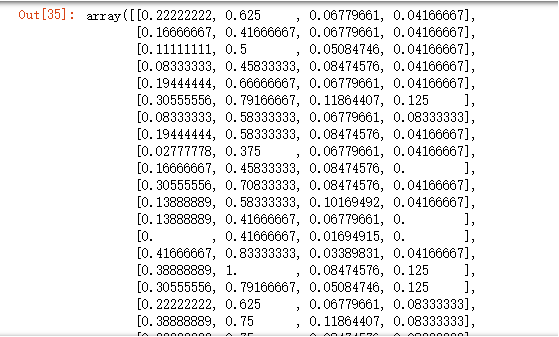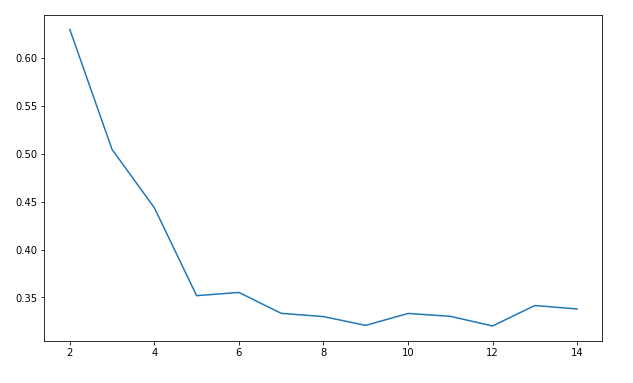sklearn——数据集调用及应用
忙了许久,总算是又想起这边还没写完呢。
那今天就写写sklearn库的一部分简单内容吧,包括数据集调用,聚类,轮廓系数等等。
自带数据集API
| 数据集函数 | 中文翻译 | 任务类型 | 数据规模 |
|---|---|---|---|
| load_boston | Boston房屋价格 | 回归 | 506*13 |
| fetch_california_housing | 加州住房 | 回归 | 20640*9 |
| load_diabetes | 糖尿病 | 回归 | 442*10 |
| load_digits | 手写字 | 分类 | 1797*64 |
| load_breast_cancer | 乳腺癌 | 分类、聚类 | (357+212)*30 |
| load_iris | 鸢尾花 | 分类、聚类 | (50*3)*4 |
| load_wine | 葡萄酒 | 分类 | (59+71+48)*13 |
| load_linnerud | 体能训练 | 多分类 | 20 |
提取信息关键字:
- DESCR:数据集的描述信息
- data:内部数据
- feature_names:数据字段名
- target:数据标签
- target_names:标签字段名(回归数据集无此项)
开始提取
以load_iris为例。
# 导入是必须的
from sklearn.datasets import load_iris
iris = load_iris()
iris # iris的所有信息,包括数据集、标签集、各字段名等
这个输出太长太乱,而且后边也有,我就不复制过来了
iris.keys() # 数据集关键字
dict_keys(['data', 'target', 'target_names', 'DESCR', 'feature_names'])
descr = iris['DESCR']
data = iris['data']
feature_names = iris['feature_names']
target = iris['target']
target_names = iris['target_names']
descr
'Iris Plants Database\n====================\n\nNotes\n-----\nData Set Characteristics:\n :Number of Instances: 150 (50 in each of three classes)\n :Number of Attributes: 4 numeric, predictive attributes and the class\n :Attribute Information:\n - sepal length in cm\n - sepal width in cm\n - petal length in cm\n - petal width in cm\n - class:\n - Iris-Setosa\n - Iris-Versicolour\n - Iris-Virginica\n :Summary Statistics:\n\n ============== ==== ==== ======= ===== ====================\n Min Max Mean SD Class Correlation\n ============== ==== ==== ======= ===== ====================\n sepal length: 4.3 7.9 5.84 0.83 0.7826\n sepal width: 2.0 4.4 3.05 0.43 -0.4194\n petal length: 1.0 6.9 3.76 1.76 0.9490 (high!)\n petal width: 0.1 2.5 1.20 0.76 0.9565 (high!)\n ============== ==== ==== ======= ===== ====================\n\n :Missing Attribute Values: None\n :Class Distribution: 33.3% for each of 3 classes.\n :Creator: R.A. Fisher\n :Donor: Michael Marshall (MARSHALL%PLU@io.arc.nasa.gov)\n :Date: July, 1988\n\nThis is a copy of UCI ML iris datasets.\nhttp://archive.ics.uci.edu/ml/datasets/Iris\n\nThe famous Iris database, first used by Sir R.A Fisher\n\nThis is perhaps the best known database to be found in the\npattern recognition literature. Fisher's paper is a classic in the field and\nis referenced frequently to this day. (See Duda & Hart, for example.) The\ndata set contains 3 classes of 50 instances each, where each class refers to a\ntype of iris plant. One class is linearly separable from the other 2; the\nlatter are NOT linearly separable from each other.\n\nReferences\n----------\n - Fisher,R.A. "The use of multiple measurements in taxonomic problems"\n Annual Eugenics, 7, Part II, 179-188 (1936); also in "Contributions to\n Mathematical Statistics" (John Wiley, NY, 1950).\n - Duda,R.O., & Hart,P.E. (1973) Pattern Classification and Scene Analysis.\n (Q327.D83) John Wiley & Sons. ISBN 0-471-22361-1. See page 218.\n - Dasarathy, B.V. (1980) "Nosing Around the Neighborhood: A New System\n Structure and Classification Rule for Recognition in Partially Exposed\n Environments". IEEE Transactions on Pattern Analysis and Machine\n Intelligence, Vol. PAMI-2, No. 1, 67-71.\n - Gates, G.W. (1972) "The Reduced Nearest Neighbor Rule". IEEE Transactions\n on Information Theory, May 1972, 431-433.\n - See also: 1988 MLC Proceedings, 54-64. Cheeseman et al"s AUTOCLASS II\n conceptual clustering system finds 3 classes in the data.\n - Many, many more ...\n'
data
array([[5.1, 3.5, 1.4, 0.2],
[4.9, 3. , 1.4, 0.2],
[4.7, 3.2, 1.3, 0.2],
[4.6, 3.1, 1.5, 0.2],
[5. , 3.6, 1.4, 0.2],
[5.4, 3.9, 1.7, 0.4],
[4.6, 3.4, 1.4, 0.3],
[5. , 3.4, 1.5, 0.2],
[4.4, 2.9, 1.4, 0.2],
[4.9, 3.1, 1.5, 0.1],
[5.4, 3.7, 1.5, 0.2],
[4.8, 3.4, 1.6, 0.2],
[4.8, 3. , 1.4, 0.1],
[4.3, 3. , 1.1, 0.1],
[5.8, 4. , 1.2, 0.2],
[5.7, 4.4, 1.5, 0.4],
[5.4, 3.9, 1.3, 0.4],
[5.1, 3.5, 1.4, 0.3],
[5.7, 3.8, 1.7, 0.3],
[5.1, 3.8, 1.5, 0.3],
[5.4, 3.4, 1.7, 0.2],
[5.1, 3.7, 1.5, 0.4],
[4.6, 3.6, 1. , 0.2],
[5.1, 3.3, 1.7, 0.5],
[4.8, 3.4, 1.9, 0.2],
[5. , 3. , 1.6, 0.2],
[5. , 3.4, 1.6, 0.4],
[5.2, 3.5, 1.5, 0.2],
[5.2, 3.4, 1.4, 0.2],
[4.7, 3.2, 1.6, 0.2],
[4.8, 3.1, 1.6, 0.2],
[5.4, 3.4, 1.5, 0.4],
[5.2, 4.1, 1.5, 0.1],
[5.5, 4.2, 1.4, 0.2],
[4.9, 3.1, 1.5, 0.1],
[5. , 3.2, 1.2, 0.2],
[5.5, 3.5, 1.3, 0.2],
[4.9, 3.1, 1.5, 0.1],
[4.4, 3. , 1.3, 0.2],
[5.1, 3.4, 1.5, 0.2],
[5. , 3.5, 1.3, 0.3],
[4.5, 2.3, 1.3, 0.3],
[4.4, 3.2, 1.3, 0.2],
[5. , 3.5, 1.6, 0.6],
[5.1, 3.8, 1.9, 0.4],
[4.8, 3. , 1.4, 0.3],
[5.1, 3.8, 1.6, 0.2],
[4.6, 3.2, 1.4, 0.2],
[5.3, 3.7, 1.5, 0.2],
[5. , 3.3, 1.4, 0.2],
[7. , 3.2, 4.7, 1.4],
[6.4, 3.2, 4.5, 1.5],
[6.9, 3.1, 4.9, 1.5],
[5.5, 2.3, 4. , 1.3],
[6.5, 2.8, 4.6, 1.5],
[5.7, 2.8, 4.5, 1.3],
[6.3, 3.3, 4.7, 1.6],
[4.9, 2.4, 3.3, 1. ],
[6.6, 2.9, 4.6, 1.3],
[5.2, 2.7, 3.9, 1.4],
[5. , 2. , 3.5, 1. ],
[5.9, 3. , 4.2, 1.5],
[6. , 2.2, 4. , 1. ],
[6.1, 2.9, 4.7, 1.4],
[5.6, 2.9, 3.6, 1.3],
[6.7, 3.1, 4.4, 1.4],
[5.6, 3. , 4.5, 1.5],
[5.8, 2.7, 4.1, 1. ],
[6.2, 2.2, 4.5, 1.5],
[5.6, 2.5, 3.9, 1.1],
[5.9, 3.2, 4.8, 1.8],
[6.1, 2.8, 4. , 1.3],
[6.3, 2.5, 4.9, 1.5],
[6.1, 2.8, 4.7, 1.2],
[6.4, 2.9, 4.3, 1.3],
[6.6, 3. , 4.4, 1.4],
[6.8, 2.8, 4.8, 1.4],
[6.7, 3. , 5. , 1.7],
[6. , 2.9, 4.5, 1.5],
[5.7, 2.6, 3.5, 1. ],
[5.5, 2.4, 3.8, 1.1],
[5.5, 2.4, 3.7, 1. ],
[5.8, 2.7, 3.9, 1.2],
[6. , 2.7, 5.1, 1.6],
[5.4, 3. , 4.5, 1.5],
[6. , 3.4, 4.5, 1.6],
[6.7, 3.1, 4.7, 1.5],
[6.3, 2.3, 4.4, 1.3],
[5.6, 3. , 4.1, 1.3],
[5.5, 2.5, 4. , 1.3],
[5.5, 2.6, 4.4, 1.2],
[6.1, 3. , 4.6, 1.4],
[5.8, 2.6, 4. , 1.2],
[5. , 2.3, 3.3, 1. ],
[5.6, 2.7, 4.2, 1.3],
[5.7, 3. , 4.2, 1.2],
[5.7, 2.9, 4.2, 1.3],
[6.2, 2.9, 4.3, 1.3],
[5.1, 2.5, 3. , 1.1],
[5.7, 2.8, 4.1, 1.3],
[6.3, 3.3, 6. , 2.5],
[5.8, 2.7, 5.1, 1.9],
[7.1, 3. , 5.9, 2.1],
[6.3, 2.9, 5.6, 1.8],
[6.5, 3. , 5.8, 2.2],
[7.6, 3. , 6.6, 2.1],
[4.9, 2.5, 4.5, 1.7],
[7.3, 2.9, 6.3, 1.8],
[6.7, 2.5, 5.8, 1.8],
[7.2, 3.6, 6.1, 2.5],
[6.5, 3.2, 5.1, 2. ],
[6.4, 2.7, 5.3, 1.9],
[6.8, 3. , 5.5, 2.1],
[5.7, 2.5, 5. , 2. ],
[5.8, 2.8, 5.1, 2.4],
[6.4, 3.2, 5.3, 2.3],
[6.5, 3. , 5.5, 1.8],
[7.7, 3.8, 6.7, 2.2],
[7.7, 2.6, 6.9, 2.3],
[6. , 2.2, 5. , 1.5],
[6.9, 3.2, 5.7, 2.3],
[5.6, 2.8, 4.9, 2. ],
[7.7, 2.8, 6.7, 2. ],
[6.3, 2.7, 4.9, 1.8],
[6.7, 3.3, 5.7, 2.1],
[7.2, 3.2, 6. , 1.8],
[6.2, 2.8, 4.8, 1.8],
[6.1, 3. , 4.9, 1.8],
[6.4, 2.8, 5.6, 2.1],
[7.2, 3. , 5.8, 1.6],
[7.4, 2.8, 6.1, 1.9],
[7.9, 3.8, 6.4, 2. ],
[6.4, 2.8, 5.6, 2.2],
[6.3, 2.8, 5.1, 1.5],
[6.1, 2.6, 5.6, 1.4],
[7.7, 3. , 6.1, 2.3],
[6.3, 3.4, 5.6, 2.4],
[6.4, 3.1, 5.5, 1.8],
[6. , 3. , 4.8, 1.8],
[6.9, 3.1, 5.4, 2.1],
[6.7, 3.1, 5.6, 2.4],
[6.9, 3.1, 5.1, 2.3],
[5.8, 2.7, 5.1, 1.9],
[6.8, 3.2, 5.9, 2.3],
[6.7, 3.3, 5.7, 2.5],
[6.7, 3. , 5.2, 2.3],
[6.3, 2.5, 5. , 1.9],
[6.5, 3. , 5.2, 2. ],
[6.2, 3.4, 5.4, 2.3],
[5.9, 3. , 5.1, 1.8]])
feature_names
['sepal length (cm)',
'sepal width (cm)',
'petal length (cm)',
'petal width (cm)']
target
array([0, 0, 0, 0, 0, 0, 0, 0, 0, 0, 0, 0, 0, 0, 0, 0, 0, 0, 0, 0, 0, 0,
0, 0, 0, 0, 0, 0, 0, 0, 0, 0, 0, 0, 0, 0, 0, 0, 0, 0, 0, 0, 0, 0,
0, 0, 0, 0, 0, 0, 1, 1, 1, 1, 1, 1, 1, 1, 1, 1, 1, 1, 1, 1, 1, 1,
1, 1, 1, 1, 1, 1, 1, 1, 1, 1, 1, 1, 1, 1, 1, 1, 1, 1, 1, 1, 1, 1,
1, 1, 1, 1, 1, 1, 1, 1, 1, 1, 1, 1, 2, 2, 2, 2, 2, 2, 2, 2, 2, 2,
2, 2, 2, 2, 2, 2, 2, 2, 2, 2, 2, 2, 2, 2, 2, 2, 2, 2, 2, 2, 2, 2,
2, 2, 2, 2, 2, 2, 2, 2, 2, 2, 2, 2, 2, 2, 2, 2, 2, 2])
target_names
array(['setosa', 'versicolor', 'virginica'], dtype='<U10')
小试一下
from sklearn.cluster import KMeans # 聚类包
from sklearn.preprocessing import StandardScaler, MinMaxScaler # 预处理包
# 标准差标准化
# 公式:(x-mean(X))/std(X)
scale = StandarScaler().fit(data) # 训练规则
X = scale.transform(data) # 应用规则
# 离差标准化(零一标准化)
# 公式:(x-min(X))/(max(X)-min(X))
scale = MinMaxScaler().fit(data) # 训练规则
X = scale.transform(data) # 应用规则
X

clf = KMeans(n_clusters = 3, random_state = 123).fit(X) # 聚成3类
clf.labels_

kmeans = KMeans(n_clusters = 3, random_state = 123).fit(data) # 用data对比一下
kmeans.labels_

target # 这里我们也可以再拿出原始标签相互对比

当然啦,先人们也是一早就想着:得找个办法来衡量一下聚类效果啊。
于是乎,轮廓系数就诞生了。
且看下方代码。
'''这里插入一下轮廓系数的一些知识点吧
1.对于第i个对象,计算它到所属簇中所有其他对象的平均距离,记ai(体现凝聚度)
2.对于第i个对象和不包含该对象的任意簇,计算该对象到给定簇中所有对象的平均距离,取最小,记bi(体现分离度)
3.第i个对象的轮廓系数为si=(bi-ai)/max(ai, bi)
所以,很明显:轮廓系数取值为[-1,1],且越大越好;若值为负,即ai>bi,说明样本被分配到错误的簇中,不可接受;若值接近0,ai≈bi,表明聚类结果有重叠的情况。
'''
from sklearn.metrics import silhouette_score # 轮廓系数
import matplotlib.pyplot as plt
silhouettteScore = []
for i in range(2,15):
kmeans = KMeans(n_clusters = i,random_state=123).fit(X) ##构建并训练模型
score = silhouette_score(X,kmeans.labels_) # X是零一化之后的数据
silhouettteScore.append(score)
plt.figure(figsize=(10,6))
plt.plot(range(2,15),silhouettteScore,linewidth=1.5, linestyle="-")
plt.show()

嗯,到此先结束吧,等下一篇我们再继续讲构建回归模型。
sklearn——数据集调用及应用的更多相关文章
- sklearn中调用PCA算法
sklearn中调用PCA算法 PCA算法是一种数据降维的方法,它可以对于数据进行维度降低,实现提高数据计算和训练的效率,而不丢失数据的重要信息,其sklearn中调用PCA算法的具体操作和代码如下所 ...
- 【学习笔记】sklearn数据集与估计器
数据集划分 机器学习一般的数据集会划分为两个部分: 训练数据:用于训练,构建模型 测试数据:在模型检验时使用,用于评估模型是否有效 训练数据和测试数据常用的比例一般为:70%: 30%, 80%: 2 ...
- Sklearn数据集与机器学习
sklearn数据集与机器学习组成 机器学习组成:模型.策略.优化 <统计机器学习>中指出:机器学习=模型+策略+算法.其实机器学习可以表示为:Learning= Representati ...
- 机器学习笔记(四)--sklearn数据集
sklearn数据集 (一)机器学习的一般数据集会划分为两个部分 训练数据:用于训练,构建模型. 测试数据:在模型检验时使用,用于评估模型是否有效. 划分数据的API:sklearn.model_se ...
- sklearn数据集
数据集划分: 机器学习一般的数据集会划分为两个部分 训练数据: 用于训练,构建模型 测试数据: 在模型检验时使用,用于评估模型是否有效 sklearn数据集划分API: 代码示例文末! scikit- ...
- sklearn数据集划分
sklearn数据集划分方法有如下方法: KFold,GroupKFold,StratifiedKFold,LeaveOneGroupOut,LeavePGroupsOut,LeaveOneOut,L ...
- sklearn中调用集成学习算法
1.集成学习是指对于同一个基础数据集使用不同的机器学习算法进行训练,最后结合不同的算法给出的意见进行决策,这个方法兼顾了许多算法的"意见",比较全面,因此在机器学习领域也使用地非常 ...
- SKLearn数据集API(一)
注:本文是人工智能研究网的学习笔记 数据集一览 类型 获取方式 自带的小数据集 sklearn.datasets.load_ 在线下载的数据集 sklearn.datasets.fetch_ 计算机生 ...
- SKLearn数据集API(二)
注:本文是人工智能研究网的学习笔记 计算机生成的数据集 用于分类任务和聚类任务,这些函数产生样本特征向量矩阵以及对应的类别标签集合. 数据集 简介 make_blobs 多类单标签数据集,为每个类分配 ...
随机推荐
- javascript中对条件判断语句的优化 分类: JavaScript 2015-06-07 09:54 832人阅读 评论(2) 收藏
不管写什么程序,平时都会用到条件语句,如:if...else... switch这样的语句,来达到对条件的判断.下面看来一段代码: function abc(test){ if (test == 1) ...
- 确保线程安全下使用Queue的Enqueue和Dequeue
场景是这样,假设有一台设备会触发类型为Alarm的告警信号,并把信号添加到一个Queue结构中,每隔一段时间这个Queue会被遍历检查,其中的每个Alarm都会调用一个相应的处理方法.问题在于,检查机 ...
- wamp配置虚拟路径(路径别名)
wamp默认的路径是安装目录下的 www 目录, 如果你想运行php代码,就需要将代码放在 www 目录下, 但这样很不方便,能否通过配置的方式,来实现 在别的目录下的 php 代码,也能正常运行和访 ...
- postcss
一.简介 PostCSS 本身是一个功能比较单一的工具.它提供了一种方式用 JavaScript 代码来处理 CSS.它负责把 CSS 代码解析成抽象语法树结构(Abstract Syntax Tre ...
- webpack4 自学笔记二(typescript的配置)
全部的代码及笔记都可以在我的github上查看, 唤醒star: https://github.com/Jasonwang911/webpackStudyInit/tree/master/typesc ...
- 【转】CSS和SVG中的剪切——clip-path属性和<clipPath>元素
本文由大漠根据SaraSoueidan的<Clipping in CSS and SVG – The clip-path Property and <clipPath> Elemen ...
- oracle 备份数据库,导出数据库
导出数据库 exp hljslfh2/hljslfh@dbsvr file=d:\hljslfh2Of0426.dmp 导入数据库 imp hljslfh2/hljslfh@localhost/dbs ...
- String 字符串相加比较
String 字符串相加 对比 public static void main(String[] args) { String a = "helloword"; final Str ...
- Java基础——GUI编程(二)
一.事件监听机制 -- 事件源:awt 或swing包中的那些图形界面组件,即发生事件的组件 -- 事件:Event 用户对组件的一个操作 -- 监听器:Listener 负责处理事件的方法 二. ...
- 杭电acm习题分类
专注于C语言编程 C Programming Practice Problems (Programming Challenges) 杭电ACM题目分类 基础题:1000.1001.1004.1005. ...
